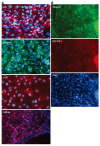Promoted differentiation of cynomolgus monkey ES cells into hepatocyte-like cells by co-culture with mouse fetal liver-derived cells
- PMID: 17106931
- PMCID: PMC4087437
- DOI: 10.3748/wjg.v12.i42.6818
Promoted differentiation of cynomolgus monkey ES cells into hepatocyte-like cells by co-culture with mouse fetal liver-derived cells
Abstract
Aim: To explore whether a co-culture of cynomolgus monkey embryonic stem (cES) cells with embryonic liver cells could promote their differentiation into hepatocytes.
Methods: Mouse fetal liver-derived cells (MFLCs) were prepared as adherent cells from mouse embryos on embryonic d (ED) 14, after which undifferentiated cES cells were co-cultured with MFLCs. The induction of cES cells along a hepatic lineage was examined in MFLC-assisted differentiation, spontaneous differentiation, and growth factors (GF) and chemicals-induced differentiations (GF-induced differentiation) using retinoic acid, leukemia inhibitory factor (LIF), FGF2, FGF4, hepatocyte growth factor (HGF), oncostatin M (OSM), and dexamethasone.
Results: The mRNA expression of alpha-fetoprotein, albumin (ALB), alpha-1-antitrypsin, and hepatocyte nuclear factor 4alpha was observed earlier in the differentiating cES cells co-cultured with MFLCs, as compared to cES cells undergoing spontaneous differentiation and those subjected to GF-induced differentiation. The expression of cytochrome P450 7a1, a possible marker for embryonic endoderm-derived mature hepatocytes, was only observed in cES cells that had differentiated in a co-culture with MFLCs. Further, the disappearance of Oct3/4, a representative marker of an undifferentiated state, was noted in cells co-cultured with MFLCs, but not in those undergoing spontaneous or GF-induced differentiation. Immunocytochemical analysis revealed an increased ratio of ALB-immunopositive cells among cES cells co-cultured with MFLCs, while glycogen storage and urea synthesis were also demonstrated.
Conclusion: MFLCs showed an ability to induce cES cells to differentiate toward hepatocytes. The co-culture system with MFLCs is a useful method for induction of hepatocyte-like cells from undifferentiated cES cells.
Figures








Similar articles
-
Hepatocytic differentiation of rhesus monkey embryonic stem cells promoted by collagen gels and growth factors.Cell Biol Int. 2011 Aug;35(8):775-81. doi: 10.1042/CBI20100354. Cell Biol Int. 2011. PMID: 21510844
-
Retaining mTeSR1 Medium during Hepatic Differentiation Facilitates Hepatocyte-Like Cell Survival by Decreasing Apoptosis.Cell Physiol Biochem. 2018;51(4):1533-1543. doi: 10.1159/000495644. Epub 2018 Nov 29. Cell Physiol Biochem. 2018. PMID: 30497075
-
Generation of functional hepatocytes from mouse germ line cell-derived pluripotent stem cells in vitro.Stem Cells Dev. 2010 Aug;19(8):1183-94. doi: 10.1089/scd.2009.0496. Stem Cells Dev. 2010. PMID: 20331356
-
[Robust differentiation of fetal hepatocytes from human embryonic stem cells and iPS].Med Sci (Paris). 2010 Dec;26(12):1061-6. doi: 10.1051/medsci/201026121061. Med Sci (Paris). 2010. PMID: 21187045 Review. French.
-
Embryonic stem cells: hepatic differentiation and regenerative medicine for the treatment of liver disease.Curr Stem Cell Res Ther. 2006 May;1(2):139-56. doi: 10.2174/157488806776956878. Curr Stem Cell Res Ther. 2006. PMID: 18220863 Review.
Cited by
-
Factors from human embryonic stem cell-derived fibroblast-like cells promote topology-dependent hepatic differentiation in primate embryonic and induced pluripotent stem cells.J Biol Chem. 2010 Oct 22;285(43):33510-33519. doi: 10.1074/jbc.M110.122093. Epub 2010 Aug 18. J Biol Chem. 2010. PMID: 20720011 Free PMC article.
-
Wharton's Jelly Mesenchymal Stem Cell: Various Protocols for Isolation and Differentiation of Hepatocyte-Like Cells; Narrative Review.Iran J Med Sci. 2019 Nov;44(6):437-448. doi: 10.30476/ijms.2019.44952. Iran J Med Sci. 2019. PMID: 31875078 Free PMC article. Review.
-
Hepatocyte differentiation.Methods Mol Biol. 2010;640:115-38. doi: 10.1007/978-1-60761-688-7_6. Methods Mol Biol. 2010. PMID: 20645049 Free PMC article.
-
Skeletal muscle-derived stem cells differentiate into hepatocyte-like cells and aid in liver regeneration.Int J Clin Exp Pathol. 2010 Mar 25;3(7):681-90. Int J Clin Exp Pathol. 2010. PMID: 20830239 Free PMC article.
-
Hepatic Differentiation of Marmoset Embryonic Stem Cells and Functional Characterization of ESC-Derived Hepatocyte-Like Cells.Hepat Med. 2020 Feb 13;12:15-27. doi: 10.2147/HMER.S243277. eCollection 2020. Hepat Med. 2020. PMID: 32104112 Free PMC article.
References
-
- Evans MJ, Kaufman MH. Establishment in culture of pluripotential cells from mouse embryos. Nature. 1981;292:154–156. - PubMed
-
- Shiroi A, Yoshikawa M, Yokota H, Fukui H, Ishizaka S, Tatsumi K, Takahashi Y. Identification of insulin-producing cells derived from embryonic stem cells by zinc-chelating dithizone. Stem Cells. 2002;20:284–292. - PubMed
-
- Yamada T, Yoshikawa M, Takaki M, Torihashi S, Kato Y, Nakajima Y, Ishizaka S, Tsunoda Y. In vitro functional gut-like organ formation from mouse embryonic stem cells. Stem Cells. 2002;20:41–49. - PubMed
Publication types
MeSH terms
Substances
LinkOut - more resources
Full Text Sources
Other Literature Sources
Miscellaneous

